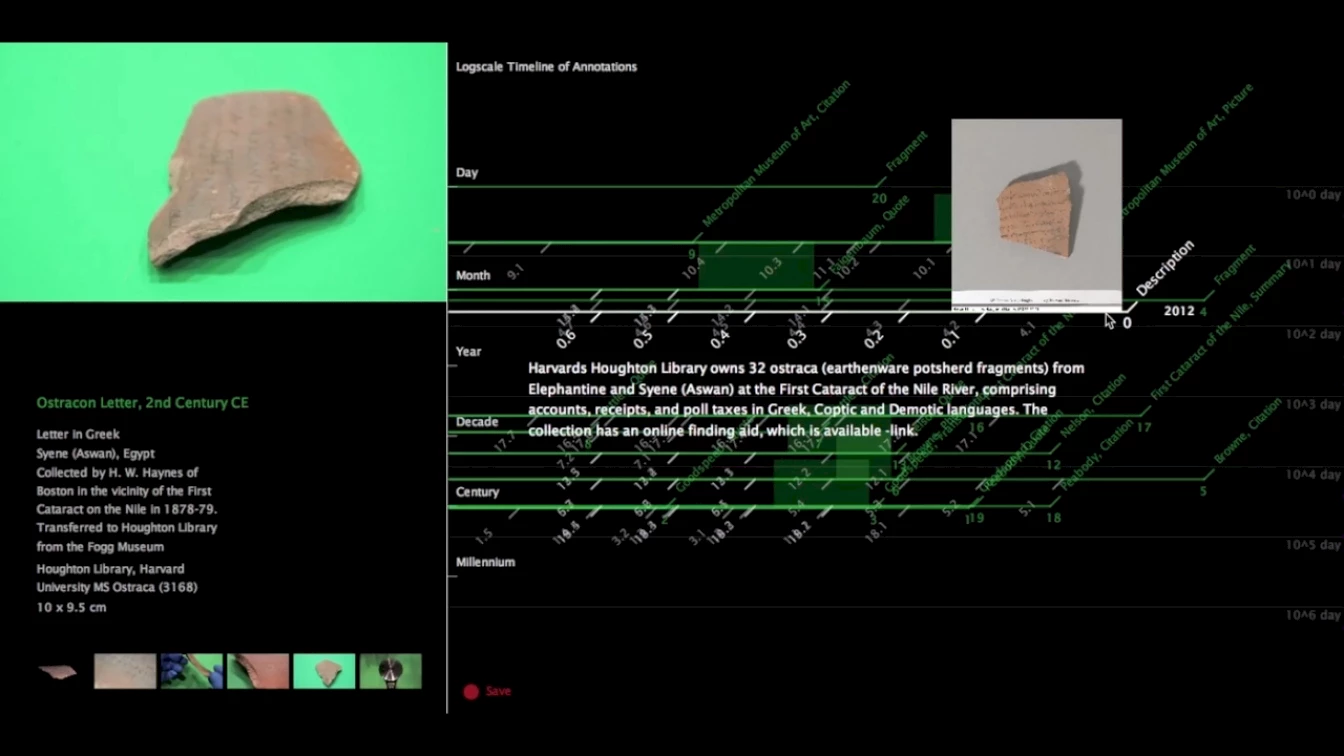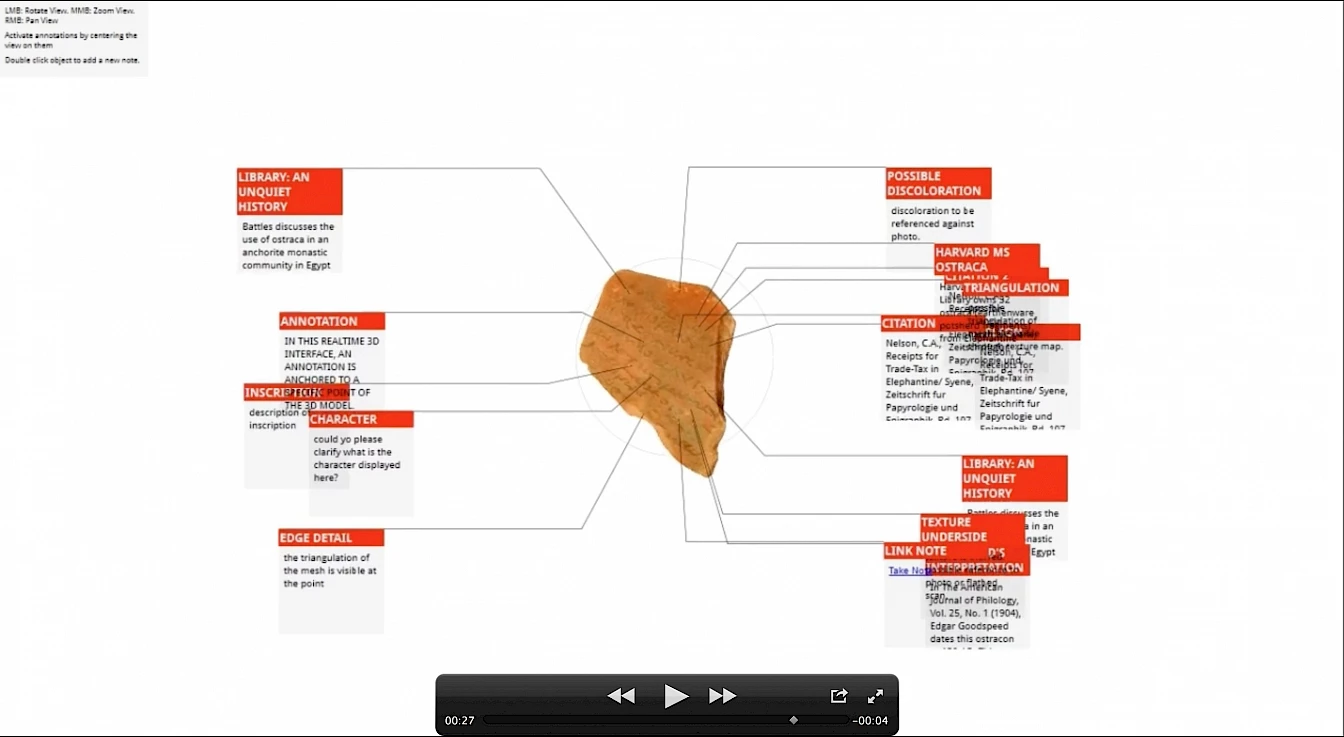
A still from metaLAB (at) Harvard's 'Teaching with Things' demonstration project (2013; project PI's Battles/Loukissas/Schnapp) with a multimedia descriptive record on the left and a timeline of annotations on the right.
Like the royal burial grounds with which they were once associated, archives were born as sites of long-term conservation whose contents were thought to have transcended temporal bounds. Few categories of materials were believed to be worthy of elevation into their supratemporal ether. There was little space for documenting the evanescent or contested features of human existence, not to mention the actions of contemporaries or peripheries, in the archivum.
In the course of their modern history, archives have undergone a democratisation that touches every aspect of their existence, from the nature of the documents collected to practices of organisation and consultation to the design of the edifices that house them. Archives now collect more varieties of media and materials than in any preceding epoch. These materials are increasingly accessible both on-site and off-site. Analogue objects lead double lives alongside digital surrogates surrounded by growing haloes of metadata, data, and capta. They do so in an array of media that extends cultural memory beyond the hand and eye to, for instance, the ear. Last but not least, this expanded sensorium of cultural memory is accompanied by new forms of capture that allow for time-scales that would have been inconceivable only a century ago: from documentation of macro-events that occur over centuries (like environmental changes) to that of micro-events that occur on the scale of seconds (viz. snapshots and tweets).
The above narrative might smack of triumphalism if the march towards democratisation, proliferation, and an expanded concept of the cultural record didn't have nested within it a series of challenges that are also opportunities for renewal. The latter encompass a rethinking of uniform processing and conservation practices; new models of search, discovery, and retrieval, as well as information use and sharing; outreach to audiences that are infrequently served by traditional brick-and-mortar archives; an augmented approach to description and cataloguing that treats every cultural object not as a singular entity but as a web of relations; and even a rethinking of the very notion of "archive" along more flexible and fluid lines. In short, a seismic shift well beyond the scope of these brief reflections in which I would like to consider three specific challenges: questions of quantity, scale and fragility.
First, quantity. By their very nature, modern institutions of memory have always been hoarders. Added to the ever-growing mass of the analogue and often duplicating them, digital archival assets have driven home a point that already applied to their analogue predecessors: namely, that mere aggregation of materials and/ or their digitisation is not, in and of itself, a gesture of conservation, not to mention an effective mechanism for activating or sustaining cultural memory. Storage is easy; activation is difficult. But a cultural heritage that lives on only as storage, whether in warehouses or in server farms, is not a living cultural heritage in any meaningful way. So how to manage the inevitable and, indeed, welcome overflows?
There is no single or simple answer because archives come in multiple shapes and sizes. One thing, however, seems certain: however invaluable, traditional top-down approaches to the processing of materials and the construction of archival repositories are, at best, an incomplete solution. This, because of the quantities and variety of materials involved as well as the fragility of their "qualities." As the Digital Archive of Japan's 2011 Disasters1 suggests, much of the fine-grained knowledge that has the potential to make contemporary materials matter is associated with the lived experience of participants and witnesses, as well as communities of expertise such as researchers and scholars. To delay their access until some hypothetical future moment when professional archivists will have had the time and (hypothetical) resources to process them can amount to a de facto death sentence. A better option, particularly in the case contemporary multimedial repositories, is to involve such interested communities in the construction and design of such animated archives right from the start. Archives live or die, are remembered or forgotten as a function of being sustained by living communities, and it is those communities themselves that must be brought into the picture in order to reduce the loss of living knowledge (which is, in turn, one significant key to future value and use). To clarify: it is not a matter of simply crowdsourcing the labour of processing, but rather of embracing database designs that balance inreach with outreach, the development of rigorous and reliable core records with the input of communities of expertise and other interested/ affected parties.

A still from metaLAB (at) Harvard's 'Teaching with Things' demonstration project (2013; project PI's Battles/Loukissas/Schnapp) showing an "artifactual interface" that allows visitors to annotate features of a three-dimensional scan of an ancient Greek ostrakon.
metaLAB played a key role in shaping the Digital Archive of Japan's 2011 Disasters into a prototype of what my colleagues and I like to call "crisis archiving". Known as the JDA, the project seeks to expand the compass of how memories are built in, attend to, and serve the present while, at the same time, ensuring the transmission of the past to future generations. Participatory in character, federative in design (involving partners from Yahoo! Japan to the National Diet Library and Archive.org), encompassing media types from tweets and photographs to testimonials generated on-site to websites and video, the JDA is made up not only of documents but also and most of all of the beehive-like curatorial and interpretive activities of the community that animates it: a community that includes everyone from victims and activists to policymakers and journalists to students, scholars, and environmental scientists.
A second challenge is cognitive and pertains to both the macro and micro scales of experiencing cultural objects. Of course, it goes without saying that archives assume the form of extremely large assemblages. Navigating them would lie well beyond the capabilities of the human mind were it not for supports such as inventories and finding aids which allow researchers to burrow in, locate and retrieve information, and build the sorts of human-scale arguments that contribute to the advancement of knowledge.
The challenge intensifies in the case of vast, interconnected, multimedial digital repositories. There was already far too much to sift through and make sense of; now there is exponentially more. But here a new set of inventorial affordances (based upon data, metadata, and capta) makes it possible to operate on new and expanded scales thanks to computational techniques. Among these are tools that translate vast numbers of objects into aggregate visualisations that can be viewed from the perspective of a multiplicity of data fields. The resulting representations tell new stories on macro scales about matters such as the history of collecting practices or institutions or taxonomical shifts. But they are not self-evident objects of human experience. On the contrary, they are technical constructs, abstractions that have to be critically crafted by means of a multitude of tools and techniques in order to generate artefacts that enhance knowledge, persuade, or make sense. This is not merely a technical task: it is the sort of cultural task being undertaken by digital humanists that involves technology, design, and a clear-headed sense of how to reconnect the world of open archives back to that middle stratum where culture resides and where human experience finds its home.
Integral to that task, but at the micro level, is the need for a relational approach to the description of objects, which is to say, the need for a concept of search that focuses upon the retrieval, not of individual items, but of the networks of interconnections that run through them. For much of the history of modern cultural institutions, the conventional acts of reduction of works to title, creator, date, snapshot, etc. were viable because the data were only visible on the inside. Collections data served the needs of inventory management and were the near-exclusive province of museum staff. But even as inventories have migrated out into public view on the World Wide Web, modes of description and representation remain much as they were in the pre-digital era: top-down, tethered to standardised schemes, based upon atomised approaches to objects.
A third challenge has to do with fragility. Digital materials may occupy little space and be readily resizable, sharable, and reproducible; the metadata, data, and capta that swirl around them may allow for new modes and scales of argument; the conditions of use and access that they enable may make it possible for everyone from high schoolers to local historians to become archive builders and archival researchers. But, for the very same reasons, digital assets are volatile, menaced by bit rot, and subject to misunderstanding and manipulation. Digital-specific techniques of conservation are still in their infancy. The oldest digital files currently preserved date back less than half a century: a mere drop in the bucket from the standpoint of cultural record.
The challenges we face today are multiple: to layer a diversity of representations on top of the standard descriptors so as to better approach the full sensorium – the weight, the texture, the feeling – of cultural objects; to unjam data resources through open APIs (Application Programme Interface) and linked data environments so as to give rise to virtual realms of curation where researchers can work with open collections data and stories can be told through and with individual objects (excavated down to the nano scale) as well as with collection-sized aggregates. Every object is a collection. Every collection is a social network of things. Objects and collections have friends. It is time to mobilise them as well as to "describe" them through representations that attend to the acoustical and haptic (not just the ocular).
Every burial ground needs to be cared for continuously if it is to endure.